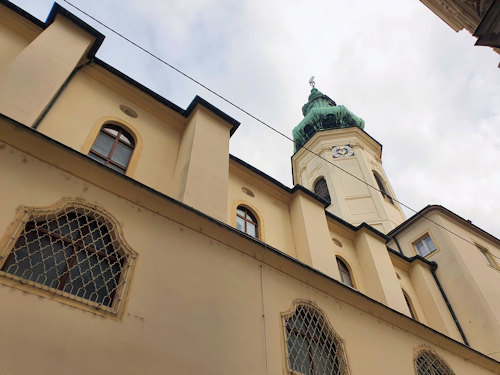Tucked away in the old town, Annakirche (St. Anne’s church) seems unassuming on the outside. But slip inside to discover an astonishing barrage of Baroque glory (and regular concerts).
- Early 16th century church
- Interior mostly early to mid-18th century
- Remarkably still & peaceful atmosphere
- Also hosts classical concerts
- Gold & pastel Baroque décor
- Book a concert* in the Annakirche
- Inexpensive for Vienna
- See also:
- Other historical churches in Vienna
- Classical concert venues
St. Anne’s Church

(The Annakirche tower arrived in 1748, replacing one lost to fire)
Vienna delivers numerous architectural and historical surprises. You find yourself on some innocent side street, and it turns out you’re standing outside somewhere Mozart used to perform.
The Annakirche (St. Anne’s church) offers another example.
Sitting somewhat incongruously opposite the New York bar, the exterior seems to promise down-to-earth interiors.
How wrong can you be?
Entering delivers a double whammy of sensorial delight: the astonishing Baroque interior and the extraordinary reverential atmosphere.

(The main entrance)
The Annakirche serves as an oasis for contemplation and prayer away from the hustle and bustle of a 21st-century city.
Such was the overpowering quiet that I winced at the sound of my pen scratching across the notepad and almost felt unable to move for fear of the noise made by my rustling coat.
(The indistinct mumbled tones of a starting confessional actually came as a relief.)
As for the decorative elements, well, this is Baroque splendour with a capital B. And all as pristine as if the craftspeople only just packed up their paints and chisels. Their motto: no stone left untouched or unpainted.
The contrast to the outside architecture is as if someone wrapped a Fabergé egg in brown parcel paper.
Concerts
Given the combination of ambience and décor, the Annakirche joins the list of central churches offering regular concerts.
For example, the Classic Exclusive series sees performances* of chamber music that draw on composers closely associated with Vienna: primarily Mozart, Beethoven, Schubert, and Haydn. Selected concerts may even feature historical instruments.
History

(Annakirche and Annagasse in a drawing by Salomon Kleiner, engraved by Johann August Corvinus and published by Johann Andreas d. Ä. Pfeffel in 1724; Wien Museum Inv.-Nr. 105765/13; excerpt reproduced with permission under the terms of the CC0 licence)
As so often with Viennese churches, the Annakirche looks back on a chequered history of rebuilding and renovation.
They consecrated the original church in the early 1500s and the first (relatively gentle) redecoration took place somewhat over 100 years later. The early 18th century then saw a Baroque transformation inside.
The final touches to produce what we more or less see today came about after a lightning strike caused a fire in 1747. As part of the restoration work, Daniel Gran painted fresh ceiling frescoes.
You find Gran’s work in other impressive locations in Vienna, too. His paintings, for example, decorate the astonishing state hall of the national library.
Architectural frescoes flank those more traditional images on the ceiling, and the general décor forms a sea of golden saints and angels, marbled russets and browns, pastel blues, pinks and yellows. It all makes for quite a sight.
The organ might almost be described as subtle in design, though the Baroque balustrade it peeps out from more than compensates.
Ticket & visitor tips
For concerts
The Classic Exclusive ensemble usually performs up to five times a week, depending on the season.
(Booking service provided by Tiqets.com*, who I am an affiliate of)
(Nothing on your dates? Try some alternative concerts*)
For visiting Annakirche
Entry to the Annakirche as such is free (bear in mind it’s a working church).
For more ecclesiastical Baroque magnificence, be sure to wander up Kärntner Straße and turn down the Graben to reach the astonishing Peterskirche (also another popular concert venue, where we enjoyed a lovely ensemble performance).
The old town has a fair few churches to explore, ranging from survivors of medieval times to more recent neogothic giants. Not to mention the landmark Gothic Stephansdom cathedral that dominates the city centre skyline. Find a list here.
How to get to the Annakirche
The Annakirche sits in the pedestrianised heart of the city down a narrow lane leading off the busy Kärntner Straße. (So narrow, in fact, that getting good photos of the church proves quite a challenge.)
Subway: the two main subway stations Stephansplatz (U1 and U3) or Karlsplatz (U1, U2 and U4) get you onto Kärntner Straße.
Tram/bus: take the 1, 2, D or 71 trams to the Karlsplatz/Oper stop and walk up into the centre. The old town bus lines also stop nearby: take the 2A to Albertinaplatz or Kärntner Straße, for example.
Address: Annagasse 3b, 1010 Vienna | Website
